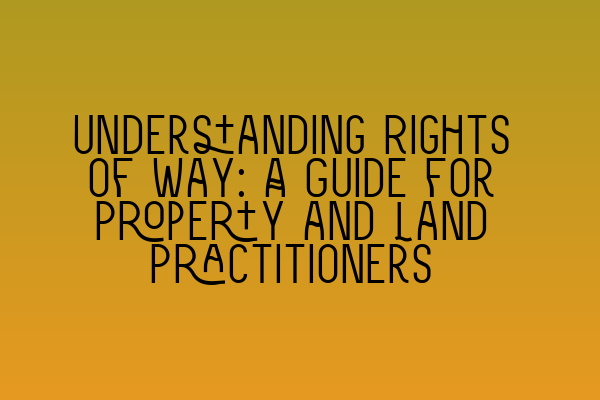Understanding Rights of Way: A Guide for Property and Land Practitioners
As property and land practitioners, it is crucial to have a comprehensive understanding of rights of way. Whether you are dealing with residential or commercial properties, being well-versed in this area of law is essential to ensure the smooth transfer of ownership and to avoid any future disputes.
What is a Right of Way?
A right of way grants someone the legal right to pass through a specific piece of land owned by someone else. It essentially allows for access from one property to another, even if it requires crossing someone else’s land. Rights of way can be granted for various reasons, such as accessing a public road or reaching a property that would otherwise be landlocked.
There are two main types of rights of way: easements and rights in gross.
Easements
An easement is a right of way that is attached to a specific property and benefits the owner of that property. This means that if a property is sold, the easement automatically transfers to the new owner. Easements can be created by necessity, implication, or express grant.
– Necessity: A right of way by necessity arises when a property is landlocked and there is no other reasonable means of access.
– Implication: An implied easement arises when it is necessary for the reasonable enjoyment of the land. For example, if a property has historically been accessed through a certain route, an implied easement may exist.
– Express Grant: An express grant occurs when the owner of the land grants a specific right of way to another party through a legally binding agreement or deed.
Rights in Gross
Rights in gross are different from easements because they do not benefit a specific property. Instead, they are personal rights granted to an individual or entity. For example, a utility company may have a right of way to access and maintain their infrastructure on someone else’s land. These rights are not transferable when the property changes hands.
How to Establish a Right of Way
Establishing a right of way requires a thorough understanding of the legal requirements and procedures. Here are some key steps to follow:
1. Review the Title Deeds
Start by reviewing the title deeds of the affected properties. Look for any easements or rights of way that have already been established. These may have been created by a previous owner or through a specific agreement. It’s crucial to determine if any existing rights of way are in place before proceeding.
Link to related article: 65. Case Studies in SQE: Applying Knowledge to Real-Life Scenarios
2. Conduct a Search
Performing a thorough search at the local land registry is essential to ascertain if any rights of way have been registered or if there are any public rights of way in the area. This search will provide valuable information and help avoid any potential conflicts.
Link to related article: 48. Unlocking Legal Research Skills for SQE Success
3. Check for Presumed Rights of Way
In some cases, if a right of way has been in continuous use for a significant period, it may be presumed as a legal right of way, even if it is not explicitly stated in the title deeds. This is known as a prescriptive easement. It is essential to investigate the history and usage of any paths or access routes to determine if this may apply.
4. Negotiate and Draft an Agreement
If a right of way needs to be established, negotiate with the affected parties and draft a legally binding agreement or deed. It is vital to clearly outline the details of the right of way, including its purpose, any restrictions or limitations, and any maintenance responsibilities. Seek the advice of an experienced property law solicitor to ensure the agreement is comprehensive and enforceable.
Link to related article: 62. SQE2: Everything You Need to Know About the Second Stage Exam
5. Register the Right of Way
Once the agreement has been finalized, it should be registered at the local land registry. This will provide official recognition of the right of way and protect the interests of all parties involved.
Resolving Right of Way Disputes
Unfortunately, disputes regarding rights of way can arise. These disputes can be complex and often require legal intervention to resolve. If you encounter a dispute, it is essential to seek legal advice from a property law solicitor who specializes in rights of way.
– Understand the specific details of the right of way, including the agreed upon terms and any limitations.
– Collect any evidence, such as photographs or documentation, that supports your position.
– Engage in open and honest communication with the opposing party to try to reach a resolution without resorting to litigation.
– If a resolution cannot be reached through negotiation, consider alternative dispute resolution methods such as mediation or arbitration.
– If all else fails, consult with your solicitor about the possibility of pursuing legal action in court.
Final Thoughts
Understanding rights of way is crucial for property and land practitioners. It is a complex area of law that requires careful analysis of title deeds, searches, and negotiations. Having a comprehensive understanding of the legal requirements and procedures will help ensure a smooth transfer of ownership and prevent future disputes.
Link to related article: 53. Functioning Legal Knowledge (FLK): Core Concepts for SQE Candidates
Remember, if you encounter any difficulties or disputes regarding rights of way, seek the advice of a qualified property law solicitor. They will guide you through the process and help you protect your clients’ interests.
Link to related article: 44. Essential SQE Textbooks: Building a Solid Foundation for Exam Prep
